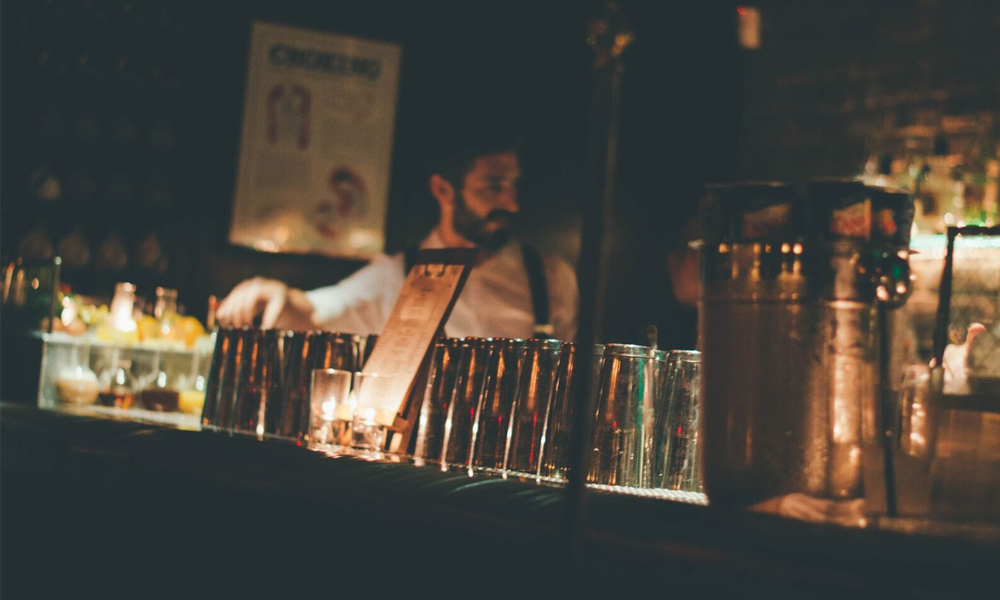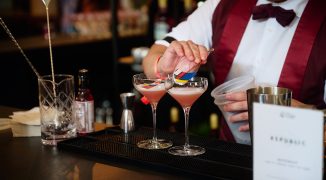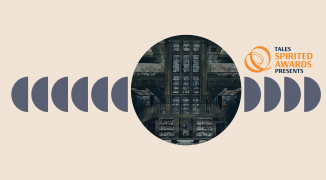Photo above by Carlos Lopez.
The moment you step foot inside Cole’s, you can feel it. A glance around the room and you can see it. Snag a seat at the bar and you can touch it, even taste it: Cole’s has history. And everybody knows it. If you didn’t, look no further than the buzzing neon sign luring thirsty patrons inside with the promise of cocktails and French Dipped sandwiches, served since 1908.
Nestled in downtown Los Angeles’ Historic Core, Cole’s is the longest continuously operating restaurant and saloon in LA. The establishment found its start over a century ago as Cole’s Pacific Electric Buffet, a pit stop for weary travelers on the old Pacific Electric Railroad. Situated on the ground floor of the Pacific Electric Building, Cole’s served as part of the main terminal for what was once the world’s largest interurban electric rail system. Before automobiles ruled the roads of Los Angeles, all lines led to Cole’s, with over 100,000 men and women passing through the hub on a daily basis. Since then, Cole’s has survived one Depression, several recessions, two world wars, Prohibition, the Civil Rights Movement, and the disbanding of the very railway system upon which it was founded.
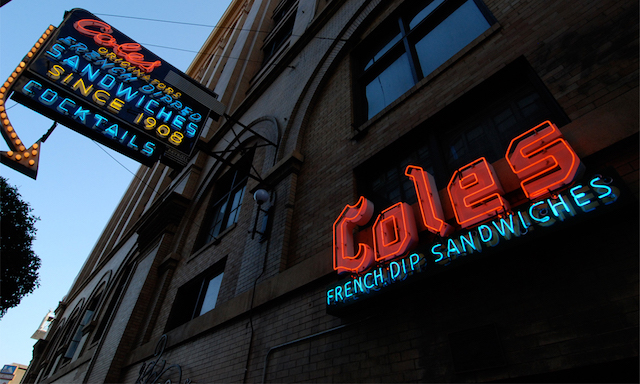 Since opening its doors, Cole’s has survived one Depression, several recessions, two world wars, Prohibition, the Civil Rights Movement, and the disbanding of the very railway system upon which it was founded. Photo courtesy of 213 Hospitality.
Since opening its doors, Cole’s has survived one Depression, several recessions, two world wars, Prohibition, the Civil Rights Movement, and the disbanding of the very railway system upon which it was founded. Photo courtesy of 213 Hospitality.
While the last Big Red Car rolled out of the old 6th and Main terminal in 1961, Cole’s has done more than withstand the test of time. The unsuspecting, brick-bound building has managed to retain both its character and customers in order to thrive in modern day Los Angeles.
Cole’s succeeds, in part, due to its responsible representation and preservation of its own historical merits. There’s something to be said for a place that keeps its history alive without feeling artificial or contrived. Cole’s isn’t a cheap replica. It doesn’t force-feed the past to its patrons. Instead of offering a gimmicky glimpse into an America that was, Cole’s provides a proper preservation of times passed. Akin to an interactive museum, Cole’s invites customers to sit where mobsters, writers, politicians, and all sorts of hard-working folks once went for a beer and a bite. From the old photos on the walls to the timeline on the menus, every corner of Cole’s houses history… even the restrooms, which are adorned with historical markers such as “Charles Bukowski Pissed Here.”
You can also sit and have a drink at Mickey’s old table, where he’s said to have set up shop on a daily basis. The entire place is brimming with stories. One of the most astounding of those stories dates back to 1933. The same day California lifted the ban on booze, Cole’s sold 19,000 gallons of beer. That’s a hell of a way to celebrate the end of Prohibition.
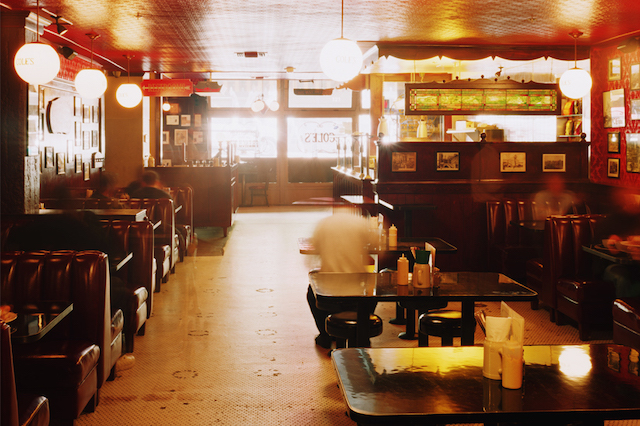 Not much has changed about Cole’s since they opened their doors in 1908, making them L.A.’s longest-operating saloon. Photo courtesy of 213 Hospitality.
Not much has changed about Cole’s since they opened their doors in 1908, making them L.A.’s longest-operating saloon. Photo courtesy of 213 Hospitality.
But perhaps the most famous story dates back to Cole’s first year of business in 1908. As the bartenders and meat carvers tell it, one of Cole’s first customers had such sensitive gums he was unable to chew the French bread on which his sandwich was served. In order to cater to the customer, house chef, Jack Garlinghouse, dipped the bread in au jus to soften it, thus making Cole’s the “Originators of the French Dip Sandwich.”
While some might say the rest is history, Cole’s claim to the French dip throne was and still is disputed by nearby Phillipe’s. Also established in 1908, Phillipe’s claims their French founder accidentally dropped a sandwich in jus to create the first of its kind. While the truth may be lost to the past, I’ll side with an origin story rooted in kindness and hospitality over one steeped in accidental jus any day. Cole’s has a way to bring out the romantic in you.
The same hospitality through which Cole’s discovered its staple sandwich is still evident today. Under dim globed lights hanging from the tin-paneled ceiling, friendly mixologists carefully craft cocktails on the mahogany bar. “We use old, original recipes,” one bartender told me before promptly whisking an egg white into a whiskey sour. Whether you prefer an Old Fashioned with a bite or a Sazerac as smooth as it smells, Cole’s Red Car Bar has you covered.
And quality and customer care aren’t the only admirable holdovers from the Cole’s of old. From the outset, Harry Cole was an innovator. He converted retired railcar doors into tabletops so his restaurant would evoke the spirit of the railway. His continued innovation transcended cosmetic upgrades, as Cole is also credited with opening Los Angeles’ first check cashing service inside the restaurant. In 1936, around 176,000 checks were cashed through Cole’s, the value of which exceeded $7,000,000, or approximately $120,000,000 today.
Harry Cole’s innovative and entrepreneurial spirit continues to permeate the place. In 2007, a nightlife investment group by the name of 213 Hospitality purchased Cole’s. The group opted to close Cole’s doors for a brief (and for the first) time in order to restore and preserve the establishment. When Cole’s reopened in 2008, it soon introduced its customers to another taste of the past.
 The Varnish, a lauded cocktail bar, is tucked away speakeasy-style in an old storage room adjacent to Cole’s. Photo by Carlos Lopez.
The Varnish, a lauded cocktail bar, is tucked away speakeasy-style in an old storage room adjacent to Cole’s. Photo by Carlos Lopez.
Tucked away in a converted storage closet sits The Varnish, an intimate speakeasy reminiscent of early 20th century gin joints. One might never know this bar within a bar existed without accidentally stumbling through a back door in a failed attempt to find the restroom — at least that’s how I discovered it. But The Varnish’s co-owner, Eric Alperin, doesn’t consider his bar a secret. “We just enjoy subtlety,” he told me.
Alperin, a New York City transplant of ten years, seems a perfect fit for a role in returning downtown Los Angeles to its former glory. “I believe everything we do in this industry has a soul that is indigenous to its location,” Mr. Alperin expressed. This sentiment certainly rings true for The Varnish, a place he describes as “a 3-cent-stamp cocktail bar. Teeny tiny with a very specific cocktail offering.”
While the menu and the space may be small, The Varnish leaves a lasting impact on its customers. The concise menu allows for craft cocktails with care and originality. The old storage space it calls home is more cozy than cramped, but perhaps cozy isn’t the best word, as Alperin hinted the space wasn’t always quite as warm and welcoming. “Back in the day, Mickey Cohen held court daily at a table in Cole’s,” said Alperin. “The Varnish was a dark windowless storage room. Mr. Cohen had a knack for roughing people up. He wasn’t going to do that in plain view mid-meal, so I think what’s now The Varnish was once his ‘back office’.”
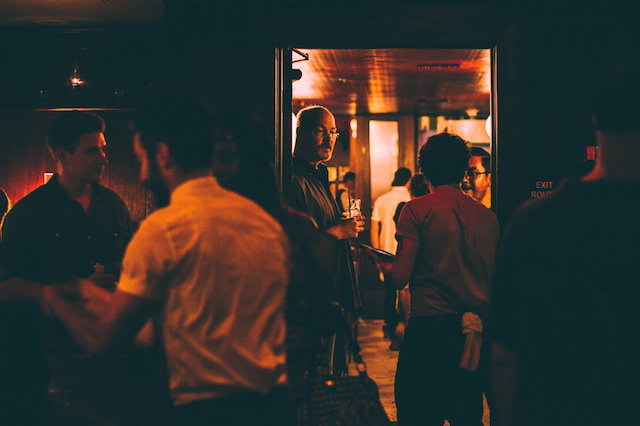 The Varnish’s co-owner, Eric Alperin, describes the bar as “a 3-cent-stamp cocktail bar. Teeny tiny with a very specific cocktail offering.” Photo: Carlos Lopez.
The Varnish’s co-owner, Eric Alperin, describes the bar as “a 3-cent-stamp cocktail bar. Teeny tiny with a very specific cocktail offering.” Photo: Carlos Lopez.
While the concept of a shared space might spell trouble for some bars, The Varnish and Cole’s coexist in a sort of symbiotic relationship. They share a space, a customer base and a charming nostalgia not often found in Los Angeles. “The best part is not only do we complement each other, but each program drives business for the other. It’s a perfect storm,” says Alperin. When pressed to come up with the hardest aspect of sharing a space with Cole’s, Alperin couldn’t muster much. “You have to remember to split certain shared costs at the end of the month, but that’s more of an accounting issue, so I remember to bring some pastries from Bottega Louie to soften the blow,” he said with a wink and a grin. “Cole’s is the home of the French dip! The Varnish is just the accompaniment,” he told me. While Cole’s may take center stage, what’s an orchestra without an accompaniment? Certainly not a symphony.
Cole’s isn’t just housing history. It is history. From its penny tile floors to its paisley velvet walls, Cole’s is a growing time capsule full of stories. In a city where everything constantly changes, Cole’s continues to outlast fading fads. In working with The Varnish, Cole’s has proven itself to be more than just a glimpse into yesteryear. It’s a picture of the present: a place where the preserved past and an ever-evolving future blend together like a French dip sandwich in a warm cup of au jus.


